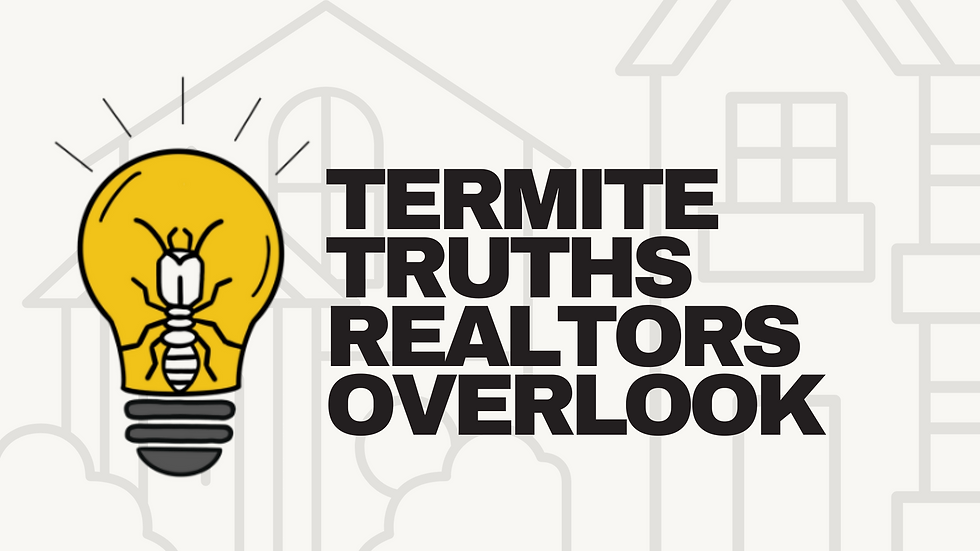What Termite Damage Looks Like (And How to Stop It)
- Jameson Elam

- Mar 24
- 3 min read
Updated: Sep 4
Termites are silent destroyers, often causing extensive damage before homeowners even notice them. If left unchecked, they can weaken the structural integrity of your home, leading to costly repairs. In this in-depth guide, we’ll explore what termite damage looks like, how termites spread, and the best ways to stop them before they cause irreversible harm.
Signs of Termite Damage
Identifying termite damage early is crucial to preventing structural issues. Here are some of the most common signs:

Hollowed or Damaged Wood – Termites eat wood from the inside out, making it sound hollow when tapped. This is often one of the first signs that homeowners notice.

Bubbling or Uneven Paint – This may indicate moisture buildup from termite activity. If you notice paint peeling or warping, it could be termites.

Mud Tubes on Walls or Foundations – A classic sign of subterranean termites creating a protected pathway. These tubes are often found on exterior walls, crawl spaces, and near foundations.

Frass (Termite Droppings) – Small, pellet-like droppings near wooden structures suggest drywood termite activity. This is often mistaken for sawdust.

Sagging or Warped Floors and Ceilings – As termites consume wood, they can weaken the support structures, leading to visible changes in floors and ceilings.

Windows and Doors That Stick – Termites often damage wooden frames, causing doors and windows to become misaligned.

Cracks in Walls – Severe infestations can compromise the structural integrity of your home, leading to cracks.
FAQs
What are the most common signs of termite damage inside walls?
Common signs include:
Hollow-sounding wood when tapped
Bubbling or uneven paint or wallpaper
Pencil‑wide mud tubes on walls or near the foundation
Small, pellet-like droppings (frass) near wood
Sagging or warped floors, ceilings, or baseboards
Doors or windows that stick or don’t open smoothly
How can I tell termite damage apart from normal wood rot?
Termite damage typically leaves wood hollow, dry, and riddled with tunnels—often with mud tubes or frass nearby. Wood rot, by contrast, is spongy, damp, and often has a musty smell. Termite damage also tends to progress faster and may involve visible termite signs like wings or droppings.
Why are mud tubes a sure sign of termite activity?
Mud tubes are built by subterranean termites to travel safely from their colony in soil to food inside your home. These tubes are often made of mud, debris, and termite saliva and visible on foundations or crawl spaces.
Can regular inspections really stop termites?
Yes. Since termite damage can hide behind walls or under flooring, annual professional inspections are key to detecting early infestations and preventing costly repairs.
How to Stop Termites
Stopping termites requires a combination of prevention, regular inspections, and professional treatment. Here’s what you can do:
1. Schedule a Professional Termite Inspection
Experts can spot early signs of an infestation that homeowners often miss. Regular inspections, at least once a year, can help detect termites before they cause major damage.
2. Eliminate Moisture Around Your Home
Termites thrive in humid conditions. Fixing leaks, ensuring proper drainage, and ensuring proper ventilation in crawl spaces can make your home less attractive to these pests.
3. Remove Wood and Debris from Around Your Home
Stacks of firewood, wooden mulch, and even old tree stumps can serve as termite food sources. Keep firewood stored at least 20 feet away from your home.
4. Seal Cracks and Entry Points
Even small cracks can serve as entry points for termites. Sealing foundation gaps, window frames, and exterior walls can help keep them out.
5. Invest in Termite Treatment
Options like borate based sprays on bare wood, bait stations, and liquid termiticides offer long-term protection. Contact Good Sense Termite to explore the best solution for your home.




Comments